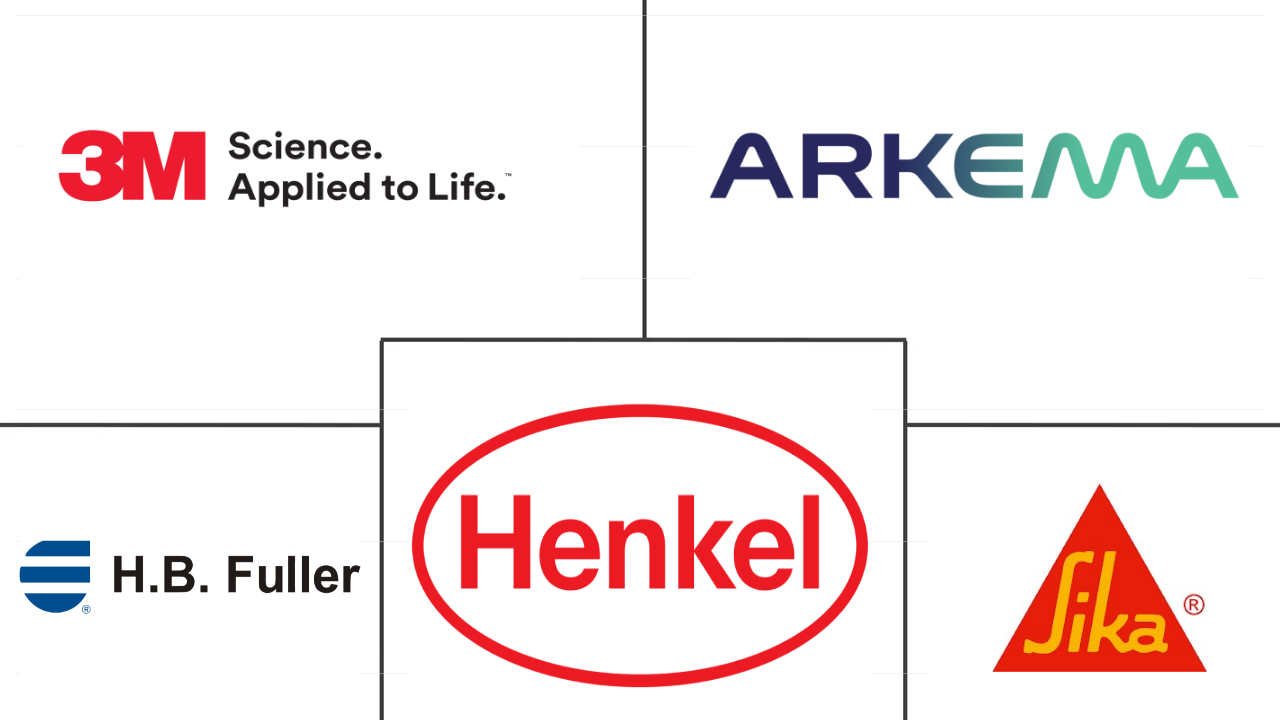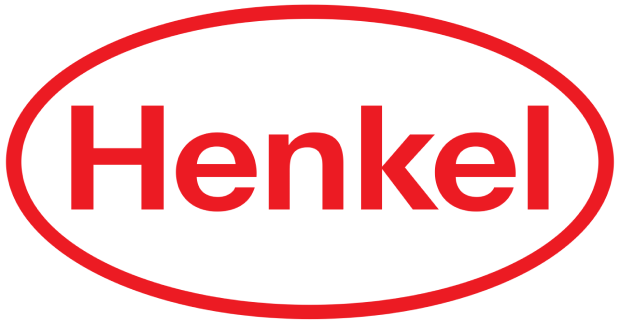Market Size of adhesives Industry
| Icons | Lable | Value |
|---|---|---|
|
|
Study Period | 2017 - 2028 |
|
|
Market Size (2024) | USD 68.88 Billion |
|
|
Market Size (2028) | USD 87.04 Billion |
|
|
Largest Share by End User Industry | Packaging |
|
|
CAGR (2024 - 2028) | 6.03 % |
|
|
Largest Share by Region | Asia-Pacific |
|
|
Market Concentration | Low |
Major Players |
||

|
||
|
*Disclaimer: Major Players sorted in no particular order |
Adhesives Market Analysis
The Adhesives Market size is estimated at 68.88 billion USD in 2024, and is expected to reach 87.04 billion USD by 2028, growing at a CAGR of 6.03% during the forecast period (2024-2028).
68.88 Billion
Market Size in 2024 (USD)
87.04 Billion
Market Size in 2028 (USD)
5.52 %
CAGR (2017-2023)
6.03 %
CAGR (2024-2028)
Largest Market by End-user Industry
42.65 %
value share, Packaging, 2023
Globally, packaging is the dominant end-user industry owing to the wide range of adhesive applications, including labels, tapes, carton sealing and joining, and laminating.
Largest Market by Technology
42.55 %
value share, Water-borne, 2023
Water-borne technology, an environmentally friendly and economically viable solution, holds a major market share due to its usage in food packaging applications through emulsion and dispersion systems.
Largest Market by Resin
23.05 %
value share, Acrylic, 2023
Acrylic-based adhesives hold a major market share owing to their pressure-sensitive applications in packaging, construction, and healthcare end-user industries.
Largest Market by Region
36.58 %
value share, Asia-Pacific, 2023
The Asia-Pacific region, driven mainly by India, China, South Korea, and Japan, is a major consumer of adhesives, owing to the usage of adhesives from various industries including packaging, construction, and automotive.
Leading Market Player
10.54 %
market share, Henkel AG & Co. KGaA, 2021

Henkel is the global leader in manufacturing adhesives. This can be attributed to the popularity of its products in various industries, including packaging, construction, and automotive.
Owing to the cheaper cost and high bonding strength to various substitutes including paper, plastic, and metal, packaging end-user to remain the largest and fastest
- Adhesives are majorly consumed in the packaging industry in the country owing to their importance in bonding plastics, metals, and paper & cardboard packaging applications. In addition, the packaging is the fastest-growing end-user of adhesives. Waterborne adhesives are highly consumed in the industry because of their cheaper cost and high bonding strength required in these applications. It is seen that nearly 8.5 million tons of water-borne adhesives are likely to be consumed in the packaging industry of the country during 2021.
- Adhesives are widely used in the construction industry because of their applications, such as waterproofing, weather-sealing, crack-sealing, and bonding. The construction industry globally is expected to record a CAGR of 3.5% up to 2030. Asia-Pacific and Europe are expected to account for 68% of the global construction market's growth. As a result, the construction industry accounts for a significant share of the global adhesives market, by value.
- Adhesives are widely used in the automotive industry because they apply to surfaces such as glass, metal, plastic, and painted surfaces. Their features are helpful, such as extreme weather resistance, durability, and long-lasting, which drive their usage in engines and car gaskets. The electric vehicles segment of the global automotive market is expected to record a CAGR of 17.75% in the forecast period because of the increase in demand for the same in growing economies. This is expected to increase the demand for automotive adhesives over the forecast period.
- Adhesives are used in the healthcare industry for applications such as assembling medical device parts. The increase in healthcare investments worldwide is expected to lead to a rise in demand in the forecast period.
Owing to the demand from construction industry, Asia-Pacific is expected to be the fastest growing
- Asia-Pacific, Europe, and North America are the largest regions in the global adhesives market. Combined, these three regions occupy 87.5% market share of the global adhesives market. The demand for adhesives declined in 2020 due to various operational restrictions because of the COVID-19 pandemic. Globally, the European adhesives market took the worst hit. It declined by 6.81% compared to the 2019 demand volume.
- In 2021, as the restrictions eased, the global demand for adhesives started recovering and outgrew the pre-pandemic levels in 2022. The demand for epoxy resin-based adhesives registered the strongest growth. In terms of volume, the demand grew by 7.67% of its 2020 volume. This growth is mainly driven by the growth in demand from building and construction and automotive end-user industries in regions like Asia-Pacific and Europe.
- Globally, adhesives based on polyurethane, acrylic, epoxy, and synthetic resins, among others, are the most prominent. These adhesives find applications in various end-user industries, including building and construction, packaging, automotive, and woodworking and joinery. The market for adhesives is estimated to grow based on the factors driving the usage of adhesives in packaging, building and construction, and automotive applications, with the adaptation of new technologies and reducing curing time.
- The market share of the Asia-Pacific adhesives market is expected to rise by 1.6% in terms of volume during the forecast period as the building and construction market is expected to register higher growth in comparison to other regions.
Adhesives Industry Segmentation
Aerospace, Automotive, Building and Construction, Footwear and Leather, Healthcare, Packaging, Woodworking and Joinery are covered as segments by End User Industry. Hot Melt, Reactive, Solvent-borne, UV Cured Adhesives, Water-borne are covered as segments by Technology. Acrylic, Cyanoacrylate, Epoxy, Polyurethane, Silicone, VAE/EVA are covered as segments by Resin. Asia-Pacific, Europe, Middle East & Africa, North America, South America are covered as segments by Region.
- Adhesives are majorly consumed in the packaging industry in the country owing to their importance in bonding plastics, metals, and paper & cardboard packaging applications. In addition, the packaging is the fastest-growing end-user of adhesives. Waterborne adhesives are highly consumed in the industry because of their cheaper cost and high bonding strength required in these applications. It is seen that nearly 8.5 million tons of water-borne adhesives are likely to be consumed in the packaging industry of the country during 2021.
- Adhesives are widely used in the construction industry because of their applications, such as waterproofing, weather-sealing, crack-sealing, and bonding. The construction industry globally is expected to record a CAGR of 3.5% up to 2030. Asia-Pacific and Europe are expected to account for 68% of the global construction market's growth. As a result, the construction industry accounts for a significant share of the global adhesives market, by value.
- Adhesives are widely used in the automotive industry because they apply to surfaces such as glass, metal, plastic, and painted surfaces. Their features are helpful, such as extreme weather resistance, durability, and long-lasting, which drive their usage in engines and car gaskets. The electric vehicles segment of the global automotive market is expected to record a CAGR of 17.75% in the forecast period because of the increase in demand for the same in growing economies. This is expected to increase the demand for automotive adhesives over the forecast period.
- Adhesives are used in the healthcare industry for applications such as assembling medical device parts. The increase in healthcare investments worldwide is expected to lead to a rise in demand in the forecast period.
| End User Industry | |
| Aerospace | |
| Automotive | |
| Building and Construction | |
| Footwear and Leather | |
| Healthcare | |
| Packaging | |
| Woodworking and Joinery | |
| Other End-user Industries |
| Technology | |
| Hot Melt | |
| Reactive | |
| Solvent-borne | |
| UV Cured Adhesives | |
| Water-borne |
| Resin | |
| Acrylic | |
| Cyanoacrylate | |
| Epoxy | |
| Polyurethane | |
| Silicone | |
| VAE/EVA | |
| Other Resins |
| Region | ||||||||||||
| ||||||||||||
| ||||||||||||
| ||||||||||||
| ||||||||||||
|
Adhesives Market Size Summary
The adhesives market is poised for significant growth, driven by its extensive applications across various industries such as packaging, construction, automotive, and healthcare. The packaging industry, in particular, is a major consumer of adhesives due to their critical role in bonding materials like plastics, metals, and paper products. Waterborne adhesives are particularly favored for their cost-effectiveness and strong bonding capabilities. The construction sector also relies heavily on adhesives for waterproofing, weather-sealing, and bonding applications, contributing to the market's expansion. Additionally, the automotive industry benefits from adhesives' durability and weather resistance, especially with the rise of electric vehicles, which are expected to boost demand further. The healthcare sector's increasing investments are anticipated to drive additional demand for adhesives used in assembling medical devices.
Regionally, Asia-Pacific, Europe, and North America dominate the global adhesives market, collectively holding a substantial market share. The market experienced a decline in 2020 due to the COVID-19 pandemic, with Europe being the hardest hit. However, demand rebounded in 2021, surpassing pre-pandemic levels by 2022, with epoxy resin-based adhesives showing particularly strong growth. Innovations in packaging, such as dissolvable and smart packaging, along with the adoption of sustainable alternatives like edible packaging, are expected to fuel further growth in the packaging sector. The automotive industry is also adapting to changing consumer preferences, with a shift towards electric vehicles and shared mobility solutions. The market remains fragmented, with key players like 3M, Arkema Group, H.B. Fuller Company, Henkel AG & Co. KGaA, and Sika AG leading the way in innovation and expansion efforts.
Adhesives Market Size - Table of Contents
-
1. MARKET SEGMENTATION (includes market size in Value in USD and Volume, Forecasts up to 2028 and analysis of growth prospects)
-
1.1 End User Industry
-
1.1.1 Aerospace
-
1.1.2 Automotive
-
1.1.3 Building and Construction
-
1.1.4 Footwear and Leather
-
1.1.5 Healthcare
-
1.1.6 Packaging
-
1.1.7 Woodworking and Joinery
-
1.1.8 Other End-user Industries
-
-
1.2 Technology
-
1.2.1 Hot Melt
-
1.2.2 Reactive
-
1.2.3 Solvent-borne
-
1.2.4 UV Cured Adhesives
-
1.2.5 Water-borne
-
-
1.3 Resin
-
1.3.1 Acrylic
-
1.3.2 Cyanoacrylate
-
1.3.3 Epoxy
-
1.3.4 Polyurethane
-
1.3.5 Silicone
-
1.3.6 VAE/EVA
-
1.3.7 Other Resins
-
-
1.4 Region
-
1.4.1 Asia-Pacific
-
1.4.1.1 Australia
-
1.4.1.2 China
-
1.4.1.3 India
-
1.4.1.4 Indonesia
-
1.4.1.5 Japan
-
1.4.1.6 Malaysia
-
1.4.1.7 Singapore
-
1.4.1.8 South Korea
-
1.4.1.9 Thailand
-
1.4.1.10 Rest of Asia-Pacific
-
-
1.4.2 Europe
-
1.4.2.1 France
-
1.4.2.2 Germany
-
1.4.2.3 Italy
-
1.4.2.4 Russia
-
1.4.2.5 Spain
-
1.4.2.6 United Kingdom
-
1.4.2.7 Rest of Europe
-
-
1.4.3 Middle East & Africa
-
1.4.3.1 Saudi Arabia
-
1.4.3.2 South Africa
-
1.4.3.3 Rest of Middle East & Africa
-
-
1.4.4 North America
-
1.4.4.1 Canada
-
1.4.4.2 Mexico
-
1.4.4.3 United States
-
1.4.4.4 Rest of North America
-
-
1.4.5 South America
-
1.4.5.1 Argentina
-
1.4.5.2 Brazil
-
1.4.5.3 Rest of South America
-
-
-
Adhesives Market Size FAQs
How big is the Global Adhesives Market?
The Global Adhesives Market size is expected to reach USD 68.88 billion in 2024 and grow at a CAGR of 6.03% to reach USD 87.04 billion by 2028.
What is the current Global Adhesives Market size?
In 2024, the Global Adhesives Market size is expected to reach USD 68.88 billion.

